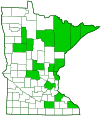fragrant waterlily
(Nymphaea odorata ssp. odorata)
Conservation • Wetland • Description • Habitat • Ecology • Use • Distribution • Taxonomy
Conservation Status |
|
|||||||
| IUCN Red List | not listed |
|||||||
| NatureServe | N5 - Secure SNR - Unranked |
|||||||
| Minnesota | not listed |
|||||||
Wetland Indicator Status |
||||||||
| Great Plains | OBL - Obligate wetland |
|||||||
| Midwest | OBL - Obligate wetland |
|||||||
| Northcentral & Northeast | OBL - Obligate wetland |
|||||||
Description |
||
Fragrant waterlily is a floating, perennial aquatic that rises up to 7′ from a frequently branched, creeping rhizome and fibrous roots. The rhizome is not constricted at the branch nodes. It often forms colonies. The leaves are all alternate and rise directly from the rhizome on a long stalk (petiole). The petiole is slender to stout and uniformly green or reddish-purple, not striped. It is round in cross section, not flattened. The leaf floats on the surface of the water, though in the spring it is submersed. The petiole is attached to the center of the underside of the blade. The blade is thick, leathery, egg-shaped to almost circular, 4″ to 16″ long, and 4″ to 16″ wide. At the base of the blade there is a very narrow slit from the margin to the petiole. There are 6 to 27 principal veins radiating from the center to the margin. There is no central web of veins between the principal veins. The upper surface is hairless and green. The lower surface is hairless and deeply reddish-purple, occasionally greenish. The margins are untoothed and sometimes strongly wavy. The inflorescence is a single flower floating on the water surface, at the end of a long stalk arising directly from the rhizome. The flower stalk resembles the leaf stalk. The flowers are 2⅜″ to 6″ in diameter when open. There are 4 sepals that rest on the surface of the water. They are egg-shaped to egg lance-shaped, 1⅛″ to 3″ long, and ⅜″ to 1″ wide. The outer side, visible when the flower is closed, is green. The inner side, visible when the flower is open, is greenish-white. There are 17 to 43 white, rarely pink, petals. They are lance-shaped to elliptic, ⅝″ to 1¼″ long, and ⅜″ to ⅞″ wide. The outermost petals have a broadly rounded tip and are arranged in a whorl of 4. The remaining petals are arranged in a spiral. There are 35 to 120 yellow stamens with yellow anthers. The filaments of the outer stamens are winged and are wider than the anthers. Those of the inner stamens are narrower than the anthers. The flower opens in the early morning and closes around noon. It lasts 3 or 4 days. The fruit is gobe-shaped. It matures underwater. |
||
Height |
||
Up to 7′ |
||
Flower Color |
||
White |
||
Similar Species |
||
American white waterlily (Nymphaea odorata ssp. tuberosa) rhizomes are often constricted at the nodes forming detachable tubers. The petioles are green with brownish-purple stripes. The lower leaf surface is green, sometimes faintly tinged with purple. American lotus (Nelumbo lutea) leaves and flowers stand up to 12″ above the water. The leaves are larger, up to 24″ in diameter, and are not split. The flowers are pale yellow and somewhat larger. |
||
Habitat |
||
Water less than 7′ deep |
||
Ecology |
||
Flowering |
||
July to September |
||
Pests and Diseases |
||
|
||
Use |
||
|
||
Distribution |
||||
|
Sources |
|||
| 2/16/2023 | ||||
Nativity |
||||
Native |
||||
Occurrence |
||||
|
||||
Taxonomy |
|||
| Kingdom | Plantae (Plants) | ||
| Subkingdom | Pteridobiotina | ||
| Phylum | Tracheophyta (Vascular Plants) | ||
| Class | Magnoliopsida (Dicots) | ||
Order |
Nymphaeales (waterlilies, fanworts, and allies) | ||
Family |
Nymphaeaceae (waterlily) | ||
| Genus | Nymphaea (water-lilies) | ||
| Subgenus | Nymphaea | ||
| Section | Nymphaea | ||
| Species | Nymphaea odorata (American white waterlily) | ||
Subordinate Taxa |
|||
|
|||
Synonyms |
|||
Castalia lekophylla Castalia minor Castalia odorata Castalia reniformis Nymphaea minor Nymphaea odorata var. gigantea Nymphaea odorata var. godfreyi Nymphaea odorata var. minor Nymphaea odorata var. rosea Nymphaea odorata var. stenopetala Nymphaea odorata var. villosa |
|||
Common Names |
|||
American white water lily American white water-lily American white waterlily fragrant water lily white water lily |
|||
Glossary
Node
The small swelling of the stem from which one or more leaves, branches, or buds originate.
Petiole
On plants: The stalk of a leaf blade or a compound leaf that attaches it to the stem. On ants and wasps: The constricted first one or two segments of the rear part of the body.
Rhizome
A horizontal, usually underground stem. It serves as a reproductive structure, producing roots below and shoots above at the nodes.
Sepal
An outer floral leaf, usually green but sometimes colored, at the base of a flower.
Visitor Photos |
|||||
Share your photo of this plant. |
|||||
| This button not working for you? Simply email us at info@MinnesotaSeasons.com. Attach one or more photos and, if you like, a caption. |
|||||
|
|||||
MinnesotaSeasons.com Photos |
|||||
|
|||||

Slideshows |
||

Visitor Videos |
|||
Share your video of this plant. |
|||
| This button not working for you? Simply email us at info@MinnesotaSeasons.com. Attach a video, a YouTube link, or a cloud storage link. |
|||
Other Videos |
|||

Visitor Sightings |
|||||
Report a sighting of this plant. |
|||||
| This button not working for you? Simply email us at info@MinnesotaSeasons.com. Be sure to include a location. |
|||||
|
|||||
MinnesotaSeasons.com Sightings |
|||||
|
|||||

|
Created: Last Updated: © MinnesotaSeasons.com. All rights reserved. |
